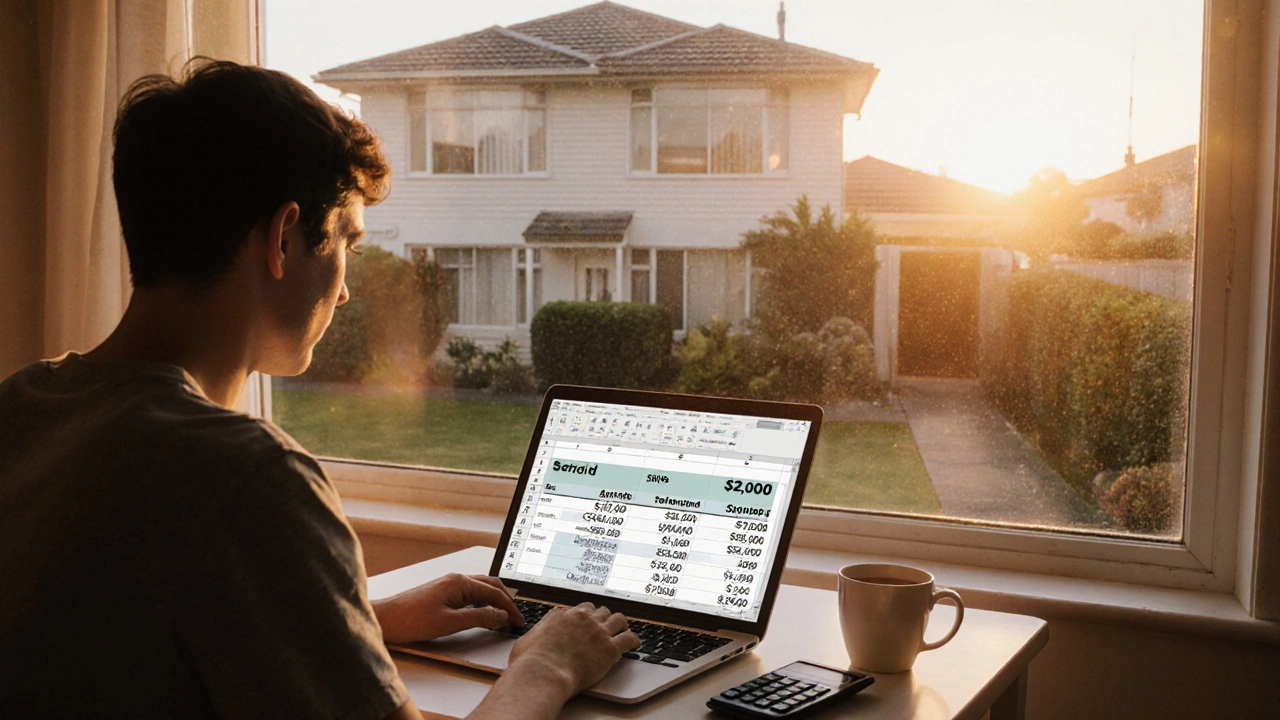Home Affordability Calculator
Calculate Your Home Affordability
Affordability Results
How Interest Rates Affect Your Payment
See how different rates impact your monthly payment:
| Interest Rate | Monthly Payment |
|---|---|
| 5.5% | $1,191 |
| 6.0% | $1,259 |
| 6.5% | $1,329 |
| 7.0% | $1,401 |
Dreaming of a house affordability milestone like a $250,000 property but pulling in just $50,000 a year? You’re not alone. Thousands of first‑time buyers in Auckland face the same math, and the answer isn’t a simple yes or no-it’s a series of calculations, assumptions, and smart choices.
Below you’ll find a step‑by‑step walkthrough that turns that daunting question into a clear plan. We’ll cover everything from the basic numbers to the hidden costs that can trip you up, and we’ll give you a quick‑look table that shows how interest‑rate shifts change what you can actually afford.
Understanding Home Purchase Affordability
Home purchase affordability is a measure of how much housing you can realistically buy given your income, debts, and the prevailing loan conditions. In New Zealand the rule of thumb is that your total housing costs (mortgage, rates, and insurance) shouldn’t exceed 30 % of gross monthly income, while your total debt‑service (including car loans, credit cards, etc.) stays under 40 %.
Step 1: Calculate Your Gross Monthly Income
Start with the simplest number: $50,000 per year equals roughly $4,167 before tax each month. After income tax and ACC levies, you’ll likely take home about $3,300. While lenders look at gross income for the 30 % rule, you’ll need to know your take‑home figure to budget for living expenses.
Step 2: Gauge Your Debt‑to‑Income (DTI) Ratio
Debt-to-Income ratio (DTI) compares monthly debt payments to gross income. If you have a car loan of $300 per month and a credit‑card minimum of $100, that’s $400 in existing debt.
DTI = ($400 / $4,167) × 100 ≈ 9.6 %. Most New Zealand banks cap total DTI at 40 %, so you’re well within the safe zone. This leaves room for a mortgage payment of roughly ($4,167 × 0.30) ≈ $1,250 per month.
Step 3: Estimate the Mortgage Amount You Can Service
Now translate that $1,250 monthly budget into a loan size. Two key variables matter:
- Interest rate - the cost of borrowing. As of October 2025 the Reserve Bank of New Zealand’s official cash rate sits at 5.25 %, and mortgage rates for a 30‑year fixed loan hover around 6.1‑6.5 % for borrowers with a good credit score.
- Loan‑to‑Value ratio (LVR) - the percentage of the property price you borrow. Most banks require a minimum 20 % deposit, meaning an LVR of 80 % for a $250,000 home.
Using a simple mortgage calculator (you can find one on the Reserve Bank’s site), a 30‑year loan at 6.3 % interest with a $1,250 monthly payment yields a loan of about $210,000. That aligns perfectly with an 80 % LVR on a $250,000 property.
Step 4: Factor in the Deposit and Savings
To hit that 20 % deposit you’ll need $50,000 upfront. If you’ve been contributing to KiwiSaver for a few years, you might be eligible to withdraw the balance for a first‑home purchase, subject to the government’s HomeStart grant. The grant can add up to $5,000 (or $10,000 in some regions) on top of your savings.
If you don’t have $50,000 saved yet, consider a shared‑ownership scheme or a lower‑price property in a more affordable suburb. The “Affordable Homes” category on our site lists neighborhoods where median house prices hover around $180,000, which would trim the required deposit to $36,000.
Step 5: Don’t Forget Ongoing Costs
Beyond the mortgage, owning a home brings several recurring expenses:
- Rates - Council property taxes in Auckland average $3,200 per year for a $250k house.
- Home insurance - Typically $800‑$1,200 annually.
- Maintenance reserve - Budget about 1 % of the property value each year ($2,500) for repairs.
Add those up and you’re looking at roughly $600 per month extra, which pushes your total housing cost to about $1,850. That’s still under the 30 % gross‑income ceiling if you count only the mortgage, but you’ll need to tighten other budget items.
Quick Comparison: How Interest‑Rate Changes Impact Affordability
| Interest Rate | Monthly Payment |
|---|---|
| 5.5 % | $1,191 |
| 6.0 % | $1,259 |
| 6.5 % | $1,329 |
| 7.0 % | $1,401 |
Notice how a half‑percentage point swing adds roughly $70 to your monthly outflow. If rates creep higher, you may need to either increase your deposit or look at cheaper properties.
Step 6: Use the Housing Affordability Index for a Reality Check
The Housing Affordability Index (HAI) published by the New Zealand Treasury tracks the ratio of median house price to median household income. In 2025 the index sits at 8.3, meaning an average family needs 8.3 times its annual income to buy a median home. For a $50k salary, that translates to a $415k median price-well above $250k. However, the index is a national average; Auckland’s market is tighter, so targeting a $250k home is still realistic if you keep the debt load low.
Step 7: Apply for Pre‑Approval
Before you start house hunting, get a pre‑approval from a lender. They’ll assess your DTI, credit score, and deposit. A pre‑approval not only tells you exactly how much you can borrow but also signals to sellers that you’re a serious buyer.

Step 8: Choose the Right Loan Product
New Zealand banks offer several loan structures:
- Fixed‑rate (2‑year, 5‑year) - protects you from rate hikes.
- Variable‑rate - may be cheaper now but can rise with the official cash rate.
- Hybrid - a fixed period followed by a variable term.
With a modest income, a 2‑year fixed at 6.1 % gives budgeting certainty, while you keep an eye on the Reserve Bank’s policy moves.
Step 9: Plan for the First‑Home Purchase Process
Here’s a quick checklist to keep you on track:
- Save the 20 % deposit plus buffer for moving costs.
- Calculate DTI and ensure it stays below 40 %.
- Get pre‑approved for a mortgage.
- Research suburbs where $250k homes are common (e.g., Hobsonville, Mangere).
- Engage a reputable estate agent familiar with first‑time buyers.
- Make an offer and negotiate inspection contingencies.
- Complete the loan application and sign the contract.
- Arrange moving and set up utilities.
Following these steps dramatically reduces the chance of a surprise that could derail your purchase.
Common Pitfalls and How to Avoid Them
Even with solid numbers, first‑time buyers stumble on a few traps:
- Over‑estimating borrowing power - Lenders may reduce the loan amount if you have hidden debts. Double‑check credit reports.
- Ignoring additional costs - Legal fees, building inspections, and stamp duty (currently $1,500‑$3,000 for a $250k home) add up fast.
- Choosing the wrong loan term - A 20‑year term would increase monthly payments considerably, which could squeeze your budget.
- Failing to lock in a rate - If rates rise after you sign the contract but before settlement, you could face higher payments.
Mitigate these by keeping a detailed spreadsheet and consulting a mortgage advisor early in the process.
When the Numbers Don’t Add Up
If after crunching the figures the monthly total still feels tight, consider these alternatives:
- Increase your income - a part‑time gig or freelance work can add $500‑$1,000 per month.
- Delay the purchase by 12‑18 months to boost savings for a larger deposit, which reduces the loan size and interest cost.
- Look at shared‑ownership schemes where you buy a portion of the property and rent the rest.
- Target a smaller‑price bracket or a townhouse instead of a stand‑alone house.
Each option has trade‑offs, but any move that lowers the loan amount improves long‑term financial health.
Final Thoughts
Yes, a $250k house is reachable on a $50k salary, but only if you manage debt, save a solid deposit, lock in a favourable mortgage rate, and stay vigilant about ongoing costs. Use the calculations here as a baseline, then tailor them to your personal circumstances.
What deposit do I need for a $250,000 house?
Most banks require at least 20 % of the purchase price, so you’d need $50,000. Using KiwiSaver savings or a HomeStart grant can help cover part of this.
Can I still buy if I have a small amount of existing debt?
Yes, as long as your total Debt‑to‑Income ratio stays below about 40 %. A $400 monthly debt load on a $50k salary yields a DTI of roughly 10 %, leaving plenty of room for a mortgage.
How much will my monthly mortgage payment be?
Assuming a 30‑year loan of $210,000 at a 6.3 % fixed rate, the payment comes to about $1,260 per month. Adjust the rate in the table above to see how it changes.
What ongoing costs should I budget for?
Expect roughly $200-$250 per month for council rates, $70-$100 for home insurance, and about $200 for a maintenance reserve. That adds around $600 to your monthly outlay.
Is a fixed‑rate mortgage better for me?
If your income is steady and you value predictability, a 2‑year fixed at ~6.1 % shields you from rate hikes while you build equity. Variable rates can be lower now but may rise with the Reserve Bank’s policy.
